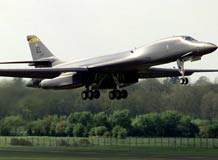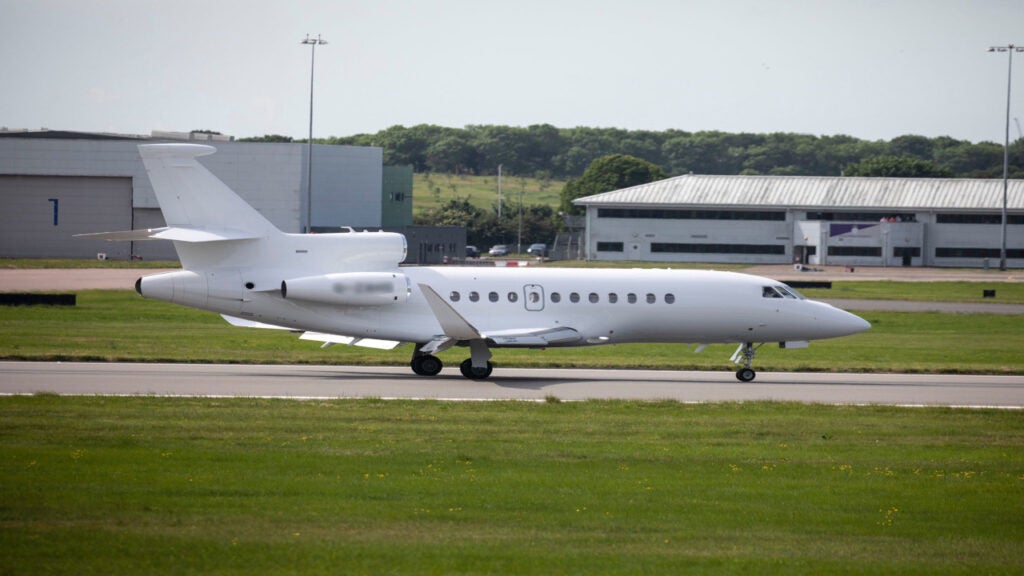
The B-1B Lancer, also known as “The Bone”, is the US Air Force long-range strategic bomber developed by Rockwell International, now Boeing Defense And Space Group.
The B-1B, which became operational in 1986, has the largest internal payload of any current bomber. The US Department of Defense announced plans to cut its B-1B inventory from 92 to 67 as a cost-saving measure in July 2001. The first aircraft was withdrawn from service in August 2002. Following Operation Iraqi Freedom, it was decided that there should be 67 aircraft in the fleet.
The remaining fleet operates from Dyess AFB, Texas (38 aircraft) and Ellsworth AFB, South Dakota (29 aircraft). in May 2010, Boeing B-1 bomber completed its 25th anniversary of operations at Dyess US Air Force Base. The aircraft is projected to be in service until 2040 and beyond.
The low radar cross section, variable-geometry wings, modern avionics, and afterburning engines enable the B-1 to carry the largest payload strike and offers long range, manoeuvrability, high speed and survivability.
The B-1B became the first aircraft to fly at supersonic speed using synthetic fuel in March 2008. The fuel was a 50/50 blend of conventional JP-8 petroleum and a synthetic fuel derived from natural gas using the Fischer-Tropsch process. The flight was part of an ongoing USAF programme to certify the alternative fuel for all USAF aircraft.
B-1B Lancer upgrade programme
Boeing received a $45m contract from the US Air Force to upgrade avionics software on the B-1 heavy bomber in February 2009.
Boeing upgraded the B-1 aircraft with a fully integrated data link (FIDL) and the upgraded aircraft took its maiden flight in July 2009. The upgrades included cockpit modifications, new processors, colour displays and communications architecture, enhancing B-1 crews’ situational awareness and communications capability and Ethernet network.
The FIDL system reduces the workload of the crew by automatically retasking the weapons system.
A sustainment block programme (SBP) was unveiled in 2003. The programme included upgrading the nation’s 67 B-1B long-range heavy bombers fleet with advanced software avionics every year.
The USAF awarded a $45m contract to Boeing for improving the B-1B bomber’s avionics software as part of the SBP in December 2007. The contract enabled work to start on the Sustainment Block SB 14. SB 14 underwent flight test at Edwards Air Force Base, California and was delivered in 2011.
A $28m contract of phase 1, which included hardware and software development, was completed in April 2009.
The US Air Force awarded initial Lot 1 contract for the Boeing Integrated Battle Station in June 2011 and a Lot 2 contract in June 2012. It took delivery of the first B-1 bomber equipped with the Boeing Integrated Battle Station in January 2014.
Boeing was awarded a $14.3bn contract by the US Air Force Life Cycle Management Center for the modernisation, modification, engineering, sustainment, and weapon system testing of B-1B Lancer and B-52 Stratofortress strategic bombers in April 2019. The work is expected to be completed by April 2029.
The US Department of Defense awarded a $26.7m contract to Aircraft Group Moog and a $21.4m contract to Thomas Instrument to remanufacture the B-1 Structural Mode Control System servo-cylinders in January 2018. The work is expected to be completed in March 2023.
B-1 bomber Sustainment Block SB 16 upgrades
The USAF has also awarded an $84m contract to Boeing in October 2009, under the SBP, for upgrading the Sustainment Block SB 16 of B-1 bomber fleet with state-of-the-art avionics software.
The upgrades encompassed changes to navigation, weapon delivery, radar, electrical multiplexing, communication/navigation management system software, controls and displays.
The USAF awarded a $23m contract to Boeing in November 2009 to upgrade the B-1 Laptop Controlled Targeting Pod software of phase 2 development. The upgrade allowed the targeting system of B-1 to identify both stationary and moving targets.
Integration of the sniper pod with the aircraft’s software delivers single-moving-target kill capability using the Guided Bomb Unit-54 (GBU-54) Laser Joint Direct Attack Munition (Laser JDAM) included as part of phase 2.
A Boeing B-1 bomber aircraft successfully completed the phase I of flight tests in December 2009 following an upgrade with fully integrated data link (FIDL). The upgrade replaced 25-year-old avionics processing, displays and keyboards.
Flight testing of the B-1 Lancer started in June 2010 following an upgrade using new digital avionics for the aft cockpit and a line-of-sight Link 16 data link. The Link 16 data link was tested by sending and receiving text messages and receiving virtual mission assignment data such as target coordinates for a weapon. Three flight tests were executed in June 2010 under B-1 programme and additional flight tests ran until January 2011.
The USAF awarded a five-year contract to L3Harris Technologies for the B-1B’s electronic countermeasures (ECM) system sustainment in June 2020. The company will provide AN/ALQ-161A repair support to the USAF as part of the contract.
Cockpit
The aircraft is operated by four crew: pilot, co-pilot, defensive systems operator (DSO) and offensive systems operator (OSO).
The DSO station is equipped with the interface for AIL Systems, Inc’s ALQ-161 defensive avionics system and a Honeywell multifunction display linked to the aircraft’s offensive avionics system (OAS). The OSO station is equipped with two Honeywell multifunction displays linked to the OAS.
Rockwell Collins received a contract in February 2004 to upgrade the displays to 5in×7in colour multifunction displays using active matrix liquid crystal (AMLCD) technology.
B-1B missile and bomb payloads
The B-1B is no longer armed with nuclear weapons but is capable of carrying the AGM-86B air launch cruise missile (ALCM) and the AGM-69 short-range attack missile.
The aircraft has three internal weapon bays and six external hardpoints under the fuselage. The maximum internal weapons payload is 75,000lb and maximum external weapons payload is 59,000lbs.
The B-1B weapons payload include 24 GBU-31 joint direct attack munition (JDAM) at one time or a combination of 24 mk84 2,000lb general purpose bombs, eight mk65 naval mines, 84 mk82 500lb general purpose bombs, 84 mk62 500lb naval mines, 30 CBU-87, -89, -97 cluster munitions, 30 CBU-103, -104, -105 wind-corrected munitions dispensor (WCMD), 24 AGM-158 joint air to surface stand-off missiles (JASSM) or 12 AGM-154 joint stand-off weapons (JSOW).
The Boeing JDAM uses global positioning system/inertial navigation guidance for delivery of the 1,000lb mk83, 1,000lb BLU-110, 2,000lb mk84 and 2,000lb BLU-109. It has a range up to 15 miles and strike precision within 13m.
The Lockheed Martin JASSM is a long-range precision standoff cruise missile with digital jam-resistant global positioning system (GPS)/inertial navigation guidance and infrared seeker.
JASSM weighs 1,020kg (2,250lb) and has a range over 370km (200nm) and a dual-mode penetrator and blast fragmentation warhead.
The B-1B successfully launched the first JASSM-ER missile, which has a range of 926km (500nm), in June 2006.
The Raytheon JSOW AGM-154A carries BLU-97 combined effects bomblets. The blast/fragmentation unitary variant AGM-154A-1 which incorporates the 500lb BLU-111 (mk82) is also fitted to the aircraft.
The AGM-154B carries BLU-108 sensor fused weapon (SFW) submunitions. Entered full-rate production in February 2005, the AGM-154C (JSOW-C) incorporates an uncooled imaging infrared (IIR) terminal seeker and tracker and has a BROACH dual-stage blast/fragmentation and/or penetrator warhead, developed by BAE Systems. JSOW has an unpowered range of 22km (12nm) low-altitude launch, 130km (70nm) high-altitude launch and a powered range of up to 325km (175nm).
B-1B aircraft were fitted with the AN/AAQ-33 Lockheed Martin Sniper ATP advanced targeting pod in June 2008. Sniper includes a mid-wave FLIR (forward-looking infrared), dual mode laser, CCD-TV, laser spot tracker and IR marker. Sniper gives the B-1B the capability for self- identification of targets and bomb damage assessment. The first series of flight tests with the new pod took place in February 2007. The B-1B equipped with the Sniper ATP made its first operational deployment in August 2008 in support of Operation Enduring Freedom.
Conventional mission upgrade programme
With the end of the Cold War, the USAF instituted the B-1B conventional mission upgrade programme.
This series of upgrades involves: Block C (completed 1997) – capability to drop cluster bombs; Block D (completed June 2001) included deployment of JDAM, new defensive system, new navigation and communications systems including the fitting of GPS to enable the dropping of satellite-guided munitions such as JDAM, and an AN/ALE-50 towed decoy system; Block E (entered service in 2005 and completed in September 2006) – capability to deploy JSOW (joint stand-off weapon), wind-compensated munitions dispenser (WCMD) and JASSM (joint air to surface stand-off missile).
JASSM entered service on the B-1 in May 2005. Block F – the defensive system upgrade programme (DSUP) – was terminated by the USAF.
As part of the Block E computer upgrade programme, in May 2002 a B-1B successfully targeted three different weapon types (mk84 bomb, mk82 bomb and CBU-89 cluster munitions) against three separate targets. In July 2003, the B-1B made the first JSOW drop from a long-range bomber.
Countermeasures
The EDO Corporation AN/ALQ-161 defensive avionics suite provides jamming against early warning radars and the fire control radars of missiles and anti-air guns. The processing algorithms are installed on an IBM AP-101F digital computer. The system also incorporates Northrop Grumman jamming transmitters, Raytheon phased array antennas and a tail warning pulse Doppler radar, which gives rear-facing hemispherical coverage.
The system’s countermeasures include dispensers for expendable decoys including chaff and flares. The defensive system upgrade programme (DSUP), which includes the AN/ALR-56 radar warner and the BAE Systems integrated defensive ECM suite (IDECM), developed for the F/A-18 fighter aircraft, is on hold but may receive funding in the future.
Radar
The Northrop Grumman APQ-164 offensive radar system is a multi-mode radar with an electronically scanned phased array antenna, which provides high-resolution terrain mapping, velocity data, beacon modes, terrain avoidance, terrain following, position data, weather detection, rendezvous and calibration modes.
Navigation and communications
The aircraft has Honeywell ASN-131 radar altimeter, Kearfott inertial navigation system, Northrop Grumman (Teledyne Ryan) APN-218 Doppler radar velocity sensor (DVS), Honeywell APN-224 radar altimeter, Rockwell Collins ARN-118 TACAN tactical air navigation system and Rockwell Collins ARN-108 instrument landing system (ILS).
The communications suite includes ASC-19 AFSATCOM satellite communications, Rockwell Collins long range ARC-190 HF radio, Honeywell KY-58 secure voice line-of-sight encryption device, Rockwell Collins ARC-171 UHF line-of-sight communications radio system, ARR-85 secure or open line-of-sight system and APX-101A IFF (identification friend or foe).
B-1B engines
The B-1B is equipped with four 30,000lb thrust class F101-GE-102 turbofan engines from General Electric. An in-flight refuelling receptacle allows refuelling from a KC-10 or a KC-135 tanker.
Performance
The B-1 Lancer can fly at a maximum speed of 1,448km/h. Its service ceiling is 9,144m. The aircraft weighs around 86,182kg and its maximum take-off weight is 216,363kg.



